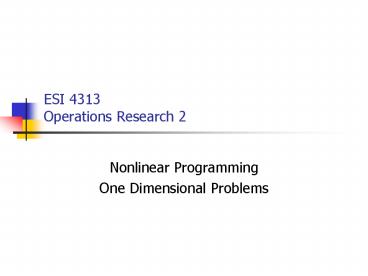ESI 4313 Operations Research 2 - PowerPoint PPT Presentation
1 / 15
Title:
ESI 4313 Operations Research 2
Description:
Use derivative information to characterize local optima ... numerical methods use the theoretical characterization of local optima via the ... – PowerPoint PPT presentation
Number of Views:38
Avg rating:3.0/5.0
Title: ESI 4313 Operations Research 2
1
ESI 4313Operations Research 2
- Nonlinear Programming
- One Dimensional Problems
2
Recap
- Nonlinear programming
- Modeling
- Structure of optimal solutions
- Local and global optimal solutions
- Role of convexity/concavity
- Can guarantee that a local optimal solution is
globally optimal
3
Recap
- One-dimensional optimization
- Recognize convexity and concavity
- Use derivative information to characterize local
optima - Find all local optima analytically/ graphically
4
Whats next?
- One-dimensional optimization
- Numerically find a local optimum for a
one-dimensional optimization problem - Multi-dimensional optimization
- Recognize convexity and concavity
- Use derivative information to characterize local
optima - Numerically find a local optimum for a
one-dimensional optimization problem
5
Numerical optimization
- If we cannot solve the problem analytically, how
do we find local optima numerically? - Many numerical methods use the theoretical
characterization of local optima via the first
and/or second order derivatives - First derivative will tell us if we have obtained
a stationary point - Second derivative will (usually) tell us the
nature of this stationary point
6
Numerical optimization
- We will make some regularity assumptions
- Objective function f is continuous and
differentiable - Feasible region is of the form a,b
- We will assume that we want to maximize f(x)
- Otherwise, simply replace the objective function
by f - We are interested in finding a local maximum
7
Numerical optimization
- The two algorithms that we will consider in more
detail are - Bisection
- Golden section search (treated only in the text)
- The bisection algorithm was originally developed
for finding the root of a function - that is, for finding a value of x where the
function of interest takes on the value 0
8
Numerical optimization
- Consider the optimization problem
- We can find a local maximum by finding a root in
a,b of f(x) 0
9
Bisection
- We assume that we have a pair of points in a,b,
say x lt x, such that - f(x) gt 0
- f(x) lt 0
- That is, the interval x,x contains a root of
f(x) 0 - Moreover, this root will correspond to a local
maximum!!
10
Example
- Consider the optimization problem
11
Example
- We wish to find a root of the equation
12
Example
- Clearly,
- f(-1½) 4.25 gt 0
- f(0) -1 lt 0
- So we can choose x-1½ and x0
13
Bisection
- The goal is to move x and x closer together
while maintaining the property that f(x) gt 0
and f(x) lt 0 - Idea
- Pick the midpoint of x and x, i.e.,
- x ½x ½x
- Evaluate f(x)
- If f(x) gt 0, replace x by x
- If f(x) lt 0, replace x by x
14
Example
x -0.75 f(x) -1.1875 x -0.75
x -1.125 f(x) 0.828 x -1.125
Etc.
15
Bisection
- We continue the process until
- x and x are close enough
- that is, we stop when x -x lt ? for some
prespecified tolerance ? - or, either f(x) or f(x) is small enough
- that is, we stop when f(x) lt ? or f(x)
lt ? for some prespecified tolerance ? - How many iterations (function evaluations) are
needed to find an approximate local maximum?































